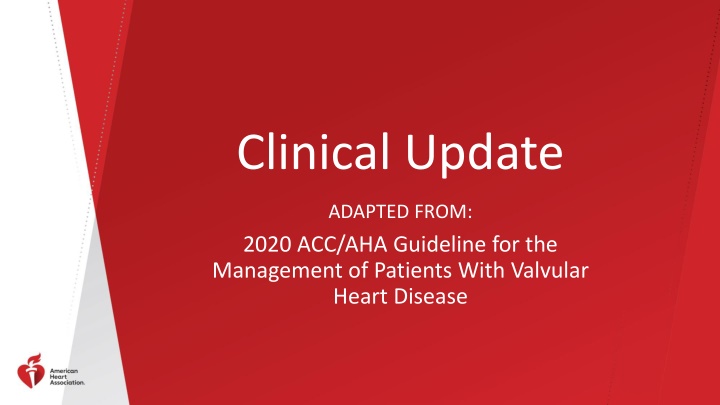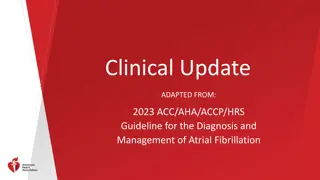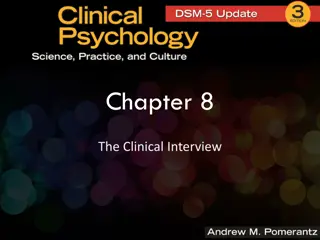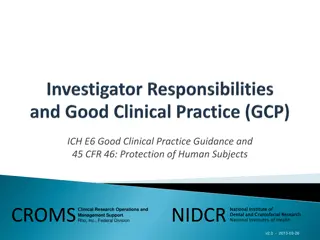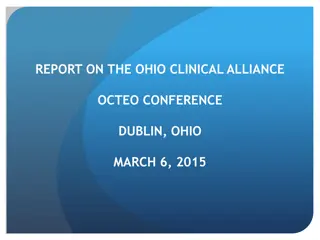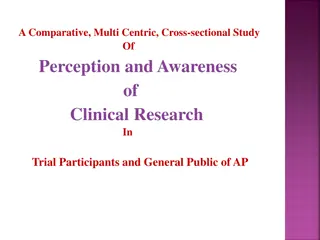Clinical Update
In this clinical update adapted from the 2020 ACC/AHA Guideline for the Management of Patients With Valvular Heart Disease, recommendations are categorized based on the strength of evidence and level of recommendation. It includes information on different classes of recommendation, levels of evidence, and phrases for writing recommendations. The document outlines guidelines for the evaluation of patients with known or suspected native valvular heart disease, emphasizing initial diagnosis, history, physical examination, presence and severity of valvular heart disease, comorbidities, heart failure, ECG and CXR evaluations, rhythm analysis, left ventricular function, hypertrophy, and concurrent issues.
Download Presentation

Please find below an Image/Link to download the presentation.
The content on the website is provided AS IS for your information and personal use only. It may not be sold, licensed, or shared on other websites without obtaining consent from the author.If you encounter any issues during the download, it is possible that the publisher has removed the file from their server.
You are allowed to download the files provided on this website for personal or commercial use, subject to the condition that they are used lawfully. All files are the property of their respective owners.
The content on the website is provided AS IS for your information and personal use only. It may not be sold, licensed, or shared on other websites without obtaining consent from the author.
E N D
Presentation Transcript
Clinical Update ADAPTED FROM: 2020 ACC/AHA Guideline for the Management of Patients With Valvular Heart Disease
CLASS (STRENGTH) OF RECOMMENDATION LEVEL (QUALITY) OF EVIDENCE CLASS 1 (STRONG) Benefit >>> Risk LEVEL A High-quality evidence from more than 1 RCT Meta-analyses of high-quality RCTs One or more RCTs corroborated by high-quality registry studies Suggested phrases for writing recommendations: Is recommended Is indicated/useful/effective/beneficial Should be performed/administered/other Comparative-Effectiveness Phrases : Treatment/strategy A is recommended/indicated in preference to treatment B Treatment A should be chosen over treatment B LEVEL B-R (Randomized) Table 1. ACC/AHA Applying Class of Recommendation and Level of Evidence to Clinical Strategies, Interventions, Treatments, or Diagnostic Testing in Patient Care (Updated May 2019)* Moderate-quality evidence from 1 or more RCTs Meta-analyses of moderate-quality RCTs LEVEL B-NR (Nonrandomized) CLASS 2a (MODERATE) Benefit >> Risk Moderate-quality evidence from 1 or more well-designed, well- executed nonrandomized studies, observational studies, or registry studies Meta-analyses of such studies Suggested phrases for writing recommendations: Is reasonable Can be useful/effective/beneficial Comparative-Effectiveness Phrases : Treatment/strategy A is probably recommended/indicated in preference to treatment B It is reasonable to choose treatment A over treatment B LEVEL C-LD (Limited Data) Randomized or nonrandomized observational or registry studies with limitations of design or execution Meta-analyses of such studies Physiological or mechanistic studies in human subjects CLASS 2b (Weak) Benefit Risk Suggested phrases for writing recommendations: May/might be reasonable May/might be considered Usefulness/effectiveness is unknown/unclear/uncertain or not well- established LEVEL C-EO (Expert Opinion) A recommendation with LOE C does not imply that the recommendation is weak. Many important clinical questions addressed in guidelines do not lend themselves to clinical trials. Although RCTs are unavailable, there may be a very clear clinical consensus that a particular test or therapy is useful or effective. COR and LOE are determined independently (any COR may be paired with any LOE). Consensus of expert opinion based on clinical experience. CLASS 3: No Benefit (MODERATE) Benefit = Risk *The outcome or result of the intervention should be specified (an improved clinical outcome or increased diagnostic accuracy or incremental prognostic information). For comparative-effectiveness recommendation (COR 1 and 2a; LOE A and B only), studies that support the use of comparator verbs should involve direct comparisons of the treatments or strategies being evaluated. Suggested phrases for writing recommendations: Is not recommended Is not indicated/useful/effective/beneficial Should not be performed/administered/other The method of assessing quality is evolving, including the application of standardized, widely-used, and preferably validated evidence grading tools; and for systematic reviews, the incorporation of an Evidence Review Committee. COR indicates Class of Recommendation; EO, expert opinion; LD, limited data; LOE, Level of Evidence; NR, nonrandomized; R, randomized; and RCT, randomized controlled trial. CLASS 3: Harm (STRONG) Risk > Benefit Suggested phrases for writing recommendations: Otto, CM et al. 2020 ACC/AHA. Guideline for the Management of Patients With Valvular Heart Disease Circulation. Potentially harmful Causes harm Associated with excess morbidity/mortality Should not be performed/administered/other 2
Evaluation of the Patient With Known or Suspected Native VHD Initial Diagnosis History & Physical VHD Presence & Severity Co-morbidities Heart Failure ECG & CXR Rhythm LV Function Hypertrophy Concurrent Valvular Disorders Associated Abnormalities LV Function & Anatomy Assessment of Valvular Anatomy & Etiology of VHD TTE Hemodynamics Stenotic Lesions Regurgitant Lesions CW & PW Doppler Flow Reversal PA Systolic Pressure RV Size Maximum velocity Mean gradient Valve area Regurgitant orifice area Regurgitant volume Regurgitant fraction Abbreviations: CW indicates continuous wave; LV, left ventricle; PASP, pulmonary artery systolic pressure; PW, pulsed wave; RV, right ventricle; TTE, transthoracic echocardiography; and VHD, valvular heart disease. Otto, CM et al. 2020 ACC/AHA. Guideline for the Management of Patients With Valvular Heart Disease Circulation. 3
Table 3. Additional Diagnostic Evaluation in VHD Additional Testing Cardiac Exercise Testing Chest X-Ray TEE CMR PET-CT Catheterization Important for symptomatic patient Provides assessment of LV volumes and function, valve severity, and aortic dilation Provides high-quality assessment of mitral and prosthetic valve, including definition of intracardiac masses & possible associated abnormalities Provides measurement of intracardiac and pulmonary pressures, valve severity, and hemodynamic response to exercise & drugs Gives an objective measure of exercise capacity Establishes heart size Aids in determination of active infection or inflammation Presence or absence of pulmonary vascular congestion, intrinsic lung disease, calcification of aorta & pericardium Quantitation of aortic regurgitant severity in selected cases. Identifies patients at high risk Pre-procedural Testing Required Before Valve Intervention CT coronary or invasive coronary angiogram Dental examination CT: Cardiac CT: Peripheral Gives an assessment of coronary anatomy Assesses femoral access for TAVI and other transcatheter procedures Assesses suitability for TAVI and other transcatheter procedures Rules out potential infection sources Abbreviations: CW indicates continuous wave; LV, left ventricle; PASP, pulmonary artery systolic pressure; PW, pulsed wave; RV, right ventricle; TTE, transthoracic echocardiography; and VHD, valvular heart disease. Otto, CM et al. 2020 ACC/AHA. Guideline for the Management of Patients With Valvular Heart Disease Circulation. 4
Table 4. Stages of VHD STAGE DEFINITION DESCRIPTION A At Risk Patients with risk factors for development of VHD Patients with progressive VHD (mild to moderate severity and asymptomatic) B Progressive Asymptomatic patients who have the criteria for severe VHD: C1: Asymptomatic patients with severe VHD in whom the LV or RV remains compensated C2: Asymptomatic patients with severe VHD with decompensation of the LV or RV C Asymptomatic Severe Patients who have developed symptoms as a result of VHD D Symptomatic Severe Abbreviations: C1 indicates stage C1; C2; stage C2; LV; left ventricle; RV, right ventricle; and VHD, valvular heart disease. Otto, CM et al. 2020 ACC/AHA. Guideline for the Management of Patients With Valvular Heart Disease Circulation. 5
Diagnostic Testing: Follow-up Established VHD New symptoms or Change in symptoms Routine follow up Yearly history & physical TTE frequency based on type and severity of lesion, known rate of progression and effect on associated ventricle Valve Other etiologies Repeat TTE dysfunction Deterioration of the ventricular response to volume or pressure overload Table 5. Frequency of Echocardiograms in Asymptomatic Patients With VHD and Normal LV Function Aortic Stenosis * Aortic Regurgitation Mitral Stenosis Mitral Regurgitation Every 3 5 y (mild severity; Vmax 2.0 2.9 m/s) Every 1 2 y moderate severity; Vmax 3.0 3.9 m/s) Every 3 5 y (mild severity) Every 1 2 y (moderate severity) Every 3 5 y (MV area >1.5 cm2) Every 3 5 y (mild severity) Every 1 2 y (moderate severity) Progressive (Stage B) Every 1 2 y (MV area 1.0 1.5 cm2) Every year (MV area <1.0 cm2) Severe asymptomatic (Stage C1) Every 6 12 mo (Vmax 4 m/s) Every 6 12 mo Dilating LV: More frequently Every 6 12 months Dilating LV: More frequently Patients with mixed valve disease may require serial evaluations at intervals earlier than recommended for single-valve lesions. These intervals apply to most patients with each valve lesion and do not take into consideration the etiology of the valve disease. *With normal stroke volume. Stages C2 and D disease are not included in this table because they would be considered candidates for intervention. Abbreviations: CMR indicates cardiac magentic resonance; LV, left ventricle; mo, month; m/s, milliseconds; MV, mitral valve; STS, Society of Thoracic Surgeons; TAVI, transcathether aortic valve implantation; TTE, trasnsthoracic echocardiography; VHD, valvular heart disease; y, year; Vmax, maximum transvalvular velocity. Otto, CM et al. 2020 ACC/AHA. Guideline for the Management of Patients With Valvular Heart Disease Circulation. 6
Recommended Treatment Regimens & Duration of Secondary Prophylaxis Table 6. Secondary Prevention of Rheumatic Fever Type Duration After Last Attack (whichever is longer)* Rheumatic fever with carditis AND persistent VHD (clinical or echo) 10 years Until patient is 40 years of age Rheumatic fever with carditis BUT NO VHD 10 years Until patient is 21 years of age Rheumatic fever WITHOUT carditis 5 years Until patient is 21 years of age Table 7. Duration of Secondary Prophylaxis for Rheumatic Fever Antibiotics for Prevention Dosage * Penicillin G benzathine 1.2 million U IM q4 weeks Penicillin V potassium 200 mg orally twice daily Sulfadiazine 1 gram orally once daily Macrolide or azalide antibiotic (for patients allergic to penicillin and sulfadiazine) Varies *In patients with documented valvular heart disease, the duration of rheumatic fever prophylaxis should be 10 y or until the patient is 40 y of age (whichever is longer). Lifelong prophylaxis may be recommended if the patient is at high risk of group A streptococcus exposure. Secondary rheumatic heart disease prophylaxis is required even after valve replacement. Administration every 3 week is recommended in certain high-risk situations. Macrolide antibiotics should not be used in persons taking other medications that inhibit cytochrome P450 3A, such as azole antifungal agents, HIV protease inhibitors, and some selective serotonin reuptake inhibitors. Abbreviations: IM indicates intramuscular; mg; milligrams; Q; every; RHD, rheumatic heart disease; U; units; and VHD, valvular heart disease. Otto, CM et al. 2020 ACC/AHA. Guideline for the Management of Patients With Valvular Heart Disease Circulation. 7
Classification of Recommendations for RHD & IE Secondary Prevention of Rheumatic Fever In patients with rheumatic heart disease, secondary prevention of rheumatic fever is indicated. 1 Infective Endocarditis Prophylaxis Antibiotic prophylaxis is reasonable before dental procedures that involve manipulation of gingival tissue, manipulation of the periapical region of teeth, or perforation of the oral mucosa in patients with VHD when: Prosthetic cardiac valves, including transcatheter prostheses and homograft Prosthetic material used for cardiac valve repair (annuloplasty rings, chords, or clips) Previous infective endocarditis Unrepaired cyanotic congenital heart disease or repaired congenital heart disease, with residual shunts or valvular regurgitation at the site of or adjacent to the site of a prosthetic patch or prosthetic device Cardiac transplant with valve regurgitation attributable to a structurally abnormal valve 2a Antibiotic prophylaxis is not recommended for nondental procedures in the absence of active infection. Examples Transesophageal echocardiogram, esophagogastroduodenoscopy, colonoscopy, or cystoscopy 3 No Benefit Abbreviations: IE indicates infective endocarditis; RHD, rheumatic heart disease; VHD valvular heart disease. Otto, CM et al. 2020 ACC/AHA. Guideline for the Management of Patients With Valvular Heart Disease Circulation. 8
Figure 1. Anticoagulation for AF in Patients With VHD Patient with VHD and AF Native valve disease (except rheumatic MS) Bioprosthetic Valve* Rheumatic MS New-onset AF within 3 months of valve implantation > 3 month after procedure Anticoagulation with VKA (2a) VKA or NOAC based on CHA2DS2-VASc Score (1) Long-term VKA anticoagulation (1) * In patients with mechanical heart valves with or without AF who require long-term anticoagulation with VKA to prevent valve thrombosis, NOACs are not recommended. Class 3:Harm. Abbreviations: AF indicates atrial fibrillation; CHA2DS2-VASc score, congestive heart failure, hypertension, age 75 years, diabetes mellitus, stroke or transient ischemic attack (TIA), vascular disease, age 65 to 74 years, sex category; MS, mitral stenosis; NOAC, non vitamin K oral anticoagulant; VHD, valvular heart disease; and VKA, vitamin K antagonist. Otto, CM et al. 2020 ACC/AHA. Guideline for the Management of Patients With Valvular Heart Disease Circulation. 9
Management of Patients with VHD After Valve Intervention Periodic Assessment is Needed If Symptoms After Valve Intervention: Procedural Complications Patient Management Post Op AF Heart Block Evaluate and treat patients with CAD risk factors according to guidelines Assess valve function Stroke Heart Failure Evaluate and treat concurrent cardiac and non-cardiac conditions Encourage heart healthy lifestyle behaviors Bleeding Renal Dysfunction For VKA anticoagulation, review INR Vascular Complications Infection Endocarditis prophylaxis Paravalvular Leak Periodic imaging Pericarditis Abbreviations: 1 indicates primary; 2 , secondary; AF, atrial fibrillation; CAD, coronary artery disease; INR, international normalized ratio; Op, operative; VHD, valvular heart disease; and VKA, vitamin K antagonist. Otto, CM et al. 2020 ACC/AHA. Guideline for the Management of Patients With Valvular Heart Disease Circulation. 10
Imaging After Valve Intervention Valve Intervention Minimal Imaging Frequency Bicuspid Aortic Valve Replacement Continue monitoring if post aortic valve replacement aortic diameter 4 cm SURGICAL Mechanical Valve Baseline Bioprosthetic Valve Baseline, 5 &10 years post surgery, then annually Mitral Valve Repair Baseline, 1 year, then every 2 to 3 years TRANSCATHETER Bioprosthetic Valve Baseline, then annually Mitral Valve Repair Baseline, then annually Abbreviations: cm indicates centimeters; LV, left ventricle; and PA, pulmonary artery. Otto, CM et al. 2020 ACC/AHA. Guideline for the Management of Patients With Valvular Heart Disease Circulation. 11
Table 13. The Evaluation and Management of Aortic Stenosis STAGE VALVE ANATOMY VALVE HEMODYNAMICS SYMPTOMS A Bicuspid aortic valve or other congenital valve anomaly Aortic valve sclerosis Aortic Vmax <2 m/s with normal leaflet motion None At risk of AS Mild to moderate leaflet calcification Fibrosis of a bicuspid or trileaflet valve with reduction in systolic motion Rheumatic valve changes with commissural fusion B Mild AS: Vmax 2-2.9 m/s or mean P <20 mmHg Moderate AS: Vmax 3-3.9 m/s or mean P 20-39 mmHg None Progressive AS C1: Asymptomatic severe AS C2: Asymptomatic severe AS with left ventricular systolic dysfunction (LVEF <50%) Both C1 and C2 may show: Severe leaflet calcification/fibrosis Congenital stenosis with severely reduced leaflet opening C1: None; exercise testing reasonable to confirm symptom status C1 and C2: Vmax 4 m/s or mean P 40 mmHg, AVA typically 1 cm2 (or AVAi 0.6 cm2/m2) but not required to define severe AS C Asymptomatic Severe AS Very severe AS: Vmax 5 m/s or mean P 60 mmHg C2: None D1: Vmax 4 m/s or mean P 40 mmHg, AVA typically 1 cm2 (or AVAi 0.6 cm2/m2) but may be larger with mixed AS/AR D1: Symptomatic severe high-gradient AS D2: Symptomatic severe low-flow low-gradient AS with reduced LVEF (<50%) D3: Symptomatic severe low-gradient AS with normal LVEF (>50%) or paradoxical low-flow severe AS D1, D2, and D3 may show: Severe leaflet calcification/fibrosis with reduced leaflet motion Exertional dyspnea, angina, syncope or presyncope, heart failure, exercise intolerance D D2: AVA 1 cm2 with Vmax <4 m/s or mean P <40 mmHg; dobutamine stress echocardiography shows AVA 1 cm2 with Vmax 4 m/s at any flow rate D3: AVA 1 cm2 with Vmax <4 m/s or mean P <40 mmHg AND stroke volume index <35 mL/m2 measured in a normotensive patient Symptomatic Severe AS Abbreviations: AR indicates aortic regurgitation; AS aortic stenosis; AVA, aortic valve area circulation; AVAi, aortic valve area indexed to body surface area; LVEF, left ventricular ejection fraction; P, pressure gradient between the left ventricle and aorta; and Vmax, maximum velocity. Otto, CM et al. 2020 ACC/AHA. Guideline for the Management of Patients With Valvular Heart Disease Circulation. 12
Figure 2. Timing of Intervention for Aortic Stenosis Abnormal Aortic Valve With Reduced Systolic Opening No AS Symptoms Symptoms due to AS Vmax <4 m/s and AVA < 1 cm2 AS Stage B Vmax 3-3.9 m/s AS Stage C Vmax >4 m/s Severe AS Stage D1 Vmax >4 m/s Pmean > 40mmhg Other Cardiac Surgery LVEF<50% ETT with drop in BP or ex. capacity Drop in LVEF to <60% on 3 serial studies LVEF <50% Vmax >5 m/s OR BNP>3x normal OR Rapid disease progression Other Cardiac Surgery YES NO Severe AS Stage D3 AVA < 0.6cm2/m2and SVI <35 ml/m2 Severe AS Stage D2 DSE Vmax>4 m/s AS most likely cause of symptoms Low surgical risk SAVR (2a) SAVR (2b) AVR (SAVR or TAVI) (1)* *See section 3.2.4.2 Abbreviations: AS indicates aortic stenosis; AVA, aortic valve area; cm, centimeter; AVR, aortic valve replacement; BNP, B-type natriuretic peptide; DSE, dobutamine stress echocardiography; ETT, exercise treadmill test; LVEF, left ventricular ejection fraction; mmHg, millimeters of mercury; Pmean,average change in pressure; SAVR, surgical aortic valve replacement; SVI, stroke volume index; TAVI, transcatheter aortic valve implantation; and Vmax, maximum transvalvular velocity. Otto, CM et al. 2020 ACC/AHA. Guideline for the Management of Patients With Valvular Heart Disease Circulation. 13
Figure 3. Choice of SAVR versus TAVI for AVR in Valvular AS Indication for AVR* Shared Decision-making with patient and Heart Valve Team with discussion of SAVR or TAVI (1) Not high or Prohibitive Risk High or Prohibitive Risk STS>8% > 2 frailty measures or < 2 organ systems or Procedural impediment Surgical Risk Assessment Amenable for VKA Anticoagulation? NO YES Bioprosthetic (1) Age <50 50-65 >65 Life expectancy with acceptable QOL >1 year? Symptomatic severe AS (D1,D2, D3) OR asymptomatic severe AS with LVEF < 50% and anatomy suitable for TF TAVI? (Individualize) Bioprosthetic (2a) SAVR YES NO Mechanical AVR (2a) YES Mechanical or Bioprosthetic (2a) NO Valve and vascular anatomy suitable for TF TAVI? Age < 65 Age >80 Age 65 to 80 Pulmonic autograft (2b) YES NO SAVR (1) TF TAVI (1) SAVR (1) TF TAVI (1) SAVR (2a) TAVI (1) Palliative Care (1) *See section 3.2.3Abbreviations: AS indicates aortic stenosis; AVR, aortic valve replacement; LVEF, left ventricular ejection fraction; QOL, quality of life; SAVR, surgical aortic valve replacement; STS, Society of Thoracic Surgeons; TAVI, transcatheter aortic valve implantation; TF, transfemoral; and VKA, vitamin K antagonist. Otto, CM et al. 2020 ACC/AHA. Guideline for the Management of Patients With Valvular Heart Disease Circulation. 14
Acute Aortic Regurgitation Abnormalities of the Valve Abnormalities of the Aorta Most often due to IE Aortic Dissection Iatrogenic complication of a transcatheter procedure Blunt chest trauma Acute volume overload in the LV Severe pulmonary congestion Low forward cardiac output Urgent diagnosis and rapid intervention are lifesaving Abbreviations: AR indicates aortic regurgitation; IE, infective endocarditis, and TAVR, transcatheter aortic valve replacement. Otto, CM et al. 2020 ACC/AHA. Guideline for the Management of Patients With Valvular Heart Disease Circulation. 15
Table 15. Stages of Chronic AR STAGE VALVE ANATOMY VALVE HEMODYNAMICS SYMPTOMS Bicuspid aortic valve Aortic valve sclerosis Diseases of the Aortic sinuses or ascending aorta Rheumatic Heart disease Infective Endocarditis A Echocardiography: None or trace AR. Angiography: Grade 0 None At risk of AS Mild AR by Echocardiography Jet width <25% of LVOT Vena contracta <0.3 cm Regurgitant volume <30 mL/beat Regurgitant fraction <30% ERO <0.10 cm2 Angiography: grade 1 Moderate AR by Echocardiography Jet width 25% 64% of LVOT Vena contracta 0.3 0.6 cm Regurgitant volume 30 59 mL/beat Regurgitant fraction 30% to 49% ERO 0.10 0.29 cm2 Angiography: Grade 2 Mild to Moderate Calcification Bicuspid aortic valve Dilated Aortic Sinuses Rheumatic Valve Changes Previous Infective Endocarditis B None Progressive AS C1: Normal LVEF (>55%) and mild to moderate LV dilation (LVESD <50 mm) Severe AR by Echocardiography Jet width 65% of LVOT Vena contracta >0.6 cm Holodiastolic flow reversal in proximal abdominal aorta Regurgitant volume 60 mL/beat Regurgitant fraction 50% ERO 0.3 cm2 Angiography: grade 3 to 4 None: Exercise testing is reasonable to confirm symptom status C Calcific valve disease Bicuspid aortic valve Dilated Aortic Sinuses or ascending aorta. Rheumatic Valve Changes Previous infective endocarditis with abnormal leaflet closure or perforation C2: Abnormal LV systolic function with depressed LVEF ( 55%) or severe LV dilation (LVESD >50 mm or indexed LVESD >25 mm/m2) Asymptomatic Severe AS In addition, diagnosis of chronic severe AR requires evidence of moderate to severe LV dilation. May occur with normal LVEF or mild/moderate or severe LV dysfunction. D Exertional dyspnea or angina or more severe HF symptoms Symptomatic Severe AS Abbreviations: AR indicates aortic regurgitation; cm. centimeter; ERO, effective regurgitant orifice; HF, heart failure; IE, infective endocarditis; LV, left ventricle; LVEF, left ventricular ejection fraction; LVESD, left ventricular end-systolic diameter; LVOT, left ventricular outflow track; mm, millimeter; and TAVR, transcatheter aortic valve replacement. Otto, CM et al. 2020 ACC/AHA. Guideline for the Management of Patients With Valvular Heart Disease Circulation. 16
Figure 4. Timing of intervention for AR Aortic Regurgitation Severe AR Moderate AR (VC>0.6 cm, holodiastolic aortic flow reversal, RVol > 60mL, RF> 50%, ERO > 0.3 cm2) Asymptomatic (Stage C) Symptomatic (Stage D) Other cardiac surgery Progressive decrease in LVEF to <55% -60% or increase in size to >65 mm on at least 3 studies LVEF >55% and/or LVESD>50 (LVESD >25mm/m2) LVEF < 55% (Stage C2) Other cardiac surgery AVR (2a) Low surgical risk AVR (2a) AVR (2b) AVR (1) Abbreviations: AR indicates aortic regurgitation; AVR, aortic valve replacement; EDD, end-diastolic dimension; ERO, effective regurgitant orifice; LVEF, left ventricular ejection fraction; LVESD, left ventricular end-systolic dimension; RF, regurgitant fraction; RVol, regurgitant volume; and VC, vena contracta. Otto, CM et al. 2020 ACC/AHA. Guideline for the Management of Patients With Valvular Heart Disease Circulation. 17
Timing of Intervention in Chronic Aortic Regurgitation COR RECOMMENDATIONS 1. In symptomatic patients with severe AR (Stage D), aortic valve surgery is indicated regardless of LV systolic function. 2. In asymptomatic patients with chronic severe AR and LV systolic dysfunction (LVEF 55%) (Stage C2), aortic valve surgery is indicated if no other cause for systolic dysfunction is identified. 1 3. In patients with severe AR (Stage C or D) who are undergoing cardiac surgery for other indications, aortic valve surgery is indicated. 4. In asymptomatic patients with severe AR and normal LV systolic function (LVEF >55%), aortic valve surgery is reasonable when the LV is severely enlarged (LVESD >50 mm or indexed LVESD >25 mm/m2) (Stage C2). 2a 5. In patients with moderate AR (Stage B) who are undergoing cardiac or aortic surgery for other indications, aortic valve surgery is reasonable. 6. In asymptomatic patients with severe AR and normal LV systolic function at rest (LVEF >55%; Stage C1) and low surgical risk, aortic valve surgery may be considered when there is a progressive decline in LVEF on at least 3 serial studies to the low normal range (LVEF 55% to 60%) or a progressive increase in LV dilation into the severe range (LV end- diastolic dimension [LVEDD] >65 mm). 2b 3 7. In patients with isolated severe AR who have indications for SAVR and are candidates for surgery, TAVI should not be performed. HARM Abbreviations: AR indicates aortic regurgitation; COR classification of recommendation; LVEF, left ventricular ejection fraction, LVESD, left ventricular end-systolic diameter; mm; millimeter; SAVR, surgical aortic valve replacement; TAVI, transcatheter aortic valve implantation. Otto, CM et al. 2020 ACC/AHA. Guideline for the Management of Patients With Valvular Heart Disease Circulation. 18
Diagnosis & Treatment: Bicuspid Aortic Valve Figure 5. Diagnosis Figure 6. Treatment Aortopathy is present in 20-40% of patients with BAV Bicuspid Aortic Valve Bicuspid Aortic Valve TTE screening of 1st degree relatives (2b) TEE including measurement of aortic sinuses and ascending aorta (1) CMR or CTA if TTE not adequate for aortic measurement (1) Aortic sinus or ascending aortic diameter 5.0-5.5 cm with risk factors for dissection* Indications for surgical AVR and aortic sinus or ascending aortic diameter >4.5cm Aortic sinus or ascending aortic diameter 5.0-5.5 cm without risk factors for dissection* Aortic sinus or ascending aortic diameter >5.5 cm Aortic diameter (sinuses or ascending aorta) 24.0 cm BAV with prior aortic valve replacement Replace aortic sinuses and/or ascending aorta if performed in low risk patients at CVC (2b) Replace aortic sinuses and/or ascending aorta (1) Replace aortic sinuses and/or ascending aorta at CVC (2a) Periodic imaging by TTE, CMR or CTA with interval determined by: Degree and rate of progression of aortic dilation Family history of aortic dissection (2a) Continued lifelong periodic imaging if aortic diameter is 24.0 cm (2a) Valve-sparing surgery may be considered at a CVC (2b) *Family history of aortic dissection, aortic growth rate 0.5 cm/y, and/or presence of aortic coarctation. Abbreviations: BAV indicates bicuspid aortic valve; CMR, cardiac magnetic resonance imaging; CTA, computed tomography angiography; CVC, comprehensive valve center; and TTE, trasnsthoracic echocardiography. Otto, CM et al. 2020 ACC/AHA. Guideline for the Management of Patients With Valvular Heart Disease Circulation. 19
Table 16. Stages of Mitral Stenosis STAGE DEFINITION/ETIOLOGY DIAGNOSTICS* SYMPTOMS A Mild valve doming during diastole Normal transmitral flow velocity None At risk of MS Increased transmitral flow velocities Mitral valve area >1.5 cm2 Diastolic pressure half-time <150 milliseconds Mild to moderate LA enlargement Normal pulmonary pressure at rest Rheumatic valve changes with commissural fusion and diastolic doming of the mitral valve leaflets Planimetered mitral valve area >1.5 cm2 B None Progressive MS C Rheumatic valve changes with commissural fusion and diastolic doming of the mitral valve leaflets Planimetered mitral valve area 1.5 cm2 Mitral valve area 1.5 cm2 Diastolic pressure half-time 150 milliseconds Severe LA enlargement Elevated PASP >50 mm Hg None Asymptomatic Severe MS D Exertional dyspnea or angina or more severe HF symptoms Symptomatic Severe MS Abbreviations: cm indicates centimeter; HTN, hypertension; LA, left atrium; mm Hg; millimeters of mercury; MS, mitral stenosis; and PASP, pulmonary artery systolic pressure. Note: DIAGNOSTICS* include Valve Hemodynamics measured by Echocardiography (doppler) or Cardiac Catheterization. Otto, CM et al. 2020 ACC/AHA. Guideline for the Management of Patients With Valvular Heart Disease Circulation. 20
Figure 7. Recommendations for Mitral Stenosis Rheumatic Mitral Stenosis Severe MS MVA <1.5cm2 Progressive MS MVA >1.5cm2 Asymptomatic Stage C Symptomatic Stage D Exertional symptoms Pliable valve No clot <2+MR Pliable valve No clot <2+MR Stress test Hemodynamically Significant MS Severe symptoms NYHA III-IV NO YES Surgical candidate Pliable valve No clot <2+MR PASP New AF >50mm HG YES NO PBMC at CVC (1) MV surgery* (1) PBMC at CVC (2b) PBMC at CVC (2a) PBMC at CVC (2b) *Repair, commissurotomy, or valve replacement. Abbreviations: AF indicates atrial fibrillation; CVC, Comprehensive Valve Center; MR, mitral regurgitation; MS, mitral stenosis; MV, mitral valve; MVA, mitral valve area; MR, Mitral Regurgitation; NYHA, New York Heart Association; PASP, pulmonary artery systolic pressure; +, plus; and PMBC, percutaneous mitral balloon commissurotomy. Otto, CM et al. 2020 ACC/AHA. Guideline for the Management of Patients With Valvular Heart Disease Circulation. 21
Table 17. Stages of Chronic Primary MR STAGE VALVE ANATOMY VALVE HEMODYNAMICS* HEMODYNAMIC CONSEQUENCES SYMPTOMS Mild mitral valve prolapse with normal coaptation Mild valve thickening and leaflet restriction No MR jet or small central jet area <20% LA on Doppler Small vena contracta <0.3 cm A None None At risk of MR Central jet MR 20% 40% LA or late systolic eccentric jet MR Vena contracta <0.7 cm Regurgitant volume <60 mL Regurgitant fraction <50% ERO <0.40 cm2 Angiographic grade 1 2 Moderate to severe mitral valve prolapse with normal coaptation Rheumatic valve changes with leaflet restriction and loss of central coaptation Prior IE Mild LA enlargement No LV enlargement Normal pulmonary pressure B None Progressive MR Mod. or severe LA enlargement LV enlargement Pulmonary hypertension may be present at rest or with exercise C1: LVEF >60% and LVESD <40 mm C2:LVEF 60% and/or LVESD 40 mm C Severe mitral valve prolapse with loss of coaptation or flail leaflet Rheumatic valve changes with leaflet restriction and loss of central coaptation Prior IE Thickening of leaflets with radiation heart disease Central jet MR >40% LA or holosystolic eccentric jet MR Vena contracta 0.7 cm Regurgitant volume 60 mL Regurgitant fraction 50% ERO 0.40 cm2 Angiographic grade 3 to 4 None Asymptomatic Severe MR D Moderate or severe LA enlargement LV enlargement Pulmonary hypertension present Decreased exercise tolerance Exertional dyspnea Symptomatic Severe MR *Valve Hemodynamics measured by echocardiography (doppler) or cardiac catheterization. Abbreviations: cm indicates centimeter; ERO, effective regurgitant orifice; IE, infective endocarditis; LA, left atrium/atrial; LV, left ventricular; LVEF, left ventricular ejection fraction; LVESD; left ventricular end-systolic dimension; mL, milliliter; mm, millimeter; and MR, mitral regurgitation. Otto, CM et al. 2020 ACC/AHA. Guideline for the Management of Patients With Valvular Heart Disease Circulation. 22
Diagnostic Testing of Primary Mitral Regurgitation COR RECOMMENDATIONS 1. For asymptomatic patients with severe primary MR (Stages B and C1), TTE is indicated every 6 to 12 months for surveillance of LV function (estimated by LVEF, LVEDD, and LVESD) and assessment of pulmonary artery pressure. 1 2. In asymptomatic patients with severe primary MR (Stages B and C1), use of serum biomarkers and novel measurements of LV function, such as global longitudinal strain, may be considered as an adjunct to guide timing of intervention. 2b Abbreviations: CMR indicates cardiac magnetic resonance; COR, classification of recommendation; GDMT, guideline directed medical therapy; LV, left ventricle, LVEDD, left ventricular end-diastolic dimension; LVEF, left ventricular ejection fraction; LVESD, left ventricular end-systolic dimension; MR, mitral regurgitation; PET, positron emission tomography; and TTE, transthoracic echocardiography. Otto, CM et al. 2020 ACC/AHA. Guideline for the Management of Patients With Valvular Heart Disease Circulation. 23
Figure 8. Management of Primary Mitral Regurgitation Severe MR (VC>0.7 cm, RVol > 60mL, RF>50%,ERO>0.40 cm2) Symptoms due to MR (Stage D) (regardless of LV function) No symptoms due to MR (Stage C) LV systolic dysfunction (Stage C2) (LVEF<60% or ESD>40 mm) Normal LV systolic Function (Stage C1) (LVEF>60% or ESD<40 mm) MV surgery (1) High or prohibitive Surgical risk with anatomy favorable for transcatheter approach and life expectancy > 1 year Expected surgical mortality <1% with >95% likelihood of successful and durable repair without residual MR Progressive increase in LV size or decrease in LVEF on at least 3 studies NO Degenerative MV disease Rheumatic MV disease Successful and durable repair possible Successful and durable repair possible YES Transcatheter edge-to-edge MV Repair (2a) MV surgery* at Primary or CVC (1) MV repair at CVC (2b) MV repair at primary or CVC (2a) MV repair or replacement (2b) .*See Prosthetic Valve section (11.1.2) for choice of mitral valve replacement if mitral valve repair is not possible. Abbreviations: CVC indicates comprehensive valve center; ERO, effective regurgitant orifice; ESD, end-systolic dimension; LVEF, ejection fraction; MR, mitral regurgitation; MV, mitral valve; MVR, mitral valve replacement; RF, regurgitant fraction; RVol, regurgitant volume; and VC, vena contracta. Otto, CM et al. 2020 ACC/AHA. Guideline for the Management of Patients With Valvular Heart Disease Circulation. 24
Diagnostic Testing Chronic Secondary Mitral Regurgitation COR RECOMMENDATIONS 1. In patients with chronic secondary MR (Stages B to D), TTE is useful to establish the etiology and to assess the extent of regional and global LV remodeling and systolic dysfunction, severity of MR, and magnitude of pulmonary hypertension. 2. In patients with chronic secondary MR (Stages B to D), noninvasive imaging (stress nuclear/ PET, CMR, or stress echocardiography), coronary CT angiography, or coronary arteriography is useful to establish etiology of MR and to assess myocardial viability. 1 3. In patients with chronic secondary MR with severe symptoms (Stage D) that are unresponsive to GDMT who are being considered for transcatheter mitral valve interventions, TEE is indicated to determine suitability for the procedure. 4. In patients with chronic secondary MR undergoing transcatheter mitral valve intervention, intraprocedural guidance with TEE is recommended. Abbreviations: CMR indicates cardiac magnetic resonance; COR, classification of recommendation; GDMT, guideline directed medical therapy; LV, left ventricle; LVEDD, left ventricular end-diastolic dimension; LVEF, left ventricular ejection fraction; LVESD, left ventricular end-systolic dimension; MR, mitral regurgitation; PET, positron emission tomography; TEE, transesophageal echocardiography; and TTE, transthoracic echocardiography. Otto, CM et al. 2020 ACC/AHA. Guideline for the Management of Patients With Valvular Heart Disease Circulation. 25
Table 18. Stages of Secondary MR STAGE VALVE ANATOMY VALVE HEMODYNAMICS* ASSOCIATED CARDIAC FINDINGS SYMPTOMS Normal or mildly dilated LV size with fixed (infarction) or inducible (ischemia) regional wall motion abnormalities Primary myocardial disease with LV dilation and systolic dysfunction Normal valve leaflets, chords, and annulus in a patient with CAD or cardiomyopathy No MR jet or small central jet area <20% LA on Doppler Small vena contracta <0.30 cm A At risk of MR Regional wall motion abnormalities with mild tethering of mitral leaflet Annular dilation with mild loss of central coaptation of the mitral leaflets Attributable to coronary ischemia or HF may be present that respond to revascularization & approp. Medical therapy ERO <0.40 cm2 Regurgitant volume <60 mL Regurgitant fraction <50% B Progressive MR Regional wall motion abnormalities with reduced LV systolic function LV dilation and systolic dysfunction attributable to primary myocardial disease C Regional wall motion abnormalities and/or LV dilation with severe tethering of mitral leaflet Annular dilation with severe loss of central coaptation of the mitral leaflets Asymptomatic Severe MR ERO 0.40 cm2 Regurgitant volume 60 mL Regurgitant fraction 50% HF symptoms attributable to MR persist even after revasc. & optimization of medical therapy Decreased exercise tolerance Exertional dyspnea D Symptomatic Severe MR *Several valve hemodynamic criteria are provided for assessment of MR severity, but not all criteria for each category will be present in each patient. Categorization of MR severity as mild, moderate, or severe depends on data quality and integration of these parameters in conjunction with other clinical evidence. The measurement of the proximal isovelocity surface area by 2D TTE in patients with secondary MR underestimates the true ERO because of the crescentic shape of the proximal convergence. May be lower in low-flow states. Abbreviations: 2D indicates 2-dimensional; CAD, coronary artery disease; ERO, effective regurgitant orifice; HF, heart failure; LA, left atrium; LV, left ventricular; MR, mitral regurgitation; and TTE, transthoracic echocardiogram. Otto, CM et al. 2020 ACC/AHA. Guideline for the Management of Patients With Valvular Heart Disease Circulation. 26
Figure 9. Secondary MR Management of Secondary Mitral Regurgitation GDMT supervised by an HF specialist (1) Undergoing CABG Severe MR Stage D (RVol >60mL, RF>50%, ERO>0.40 cm2) LVEF > 50% LVEF < 50% Persistent Symptoms on optimal GDMT Persistent Symptoms on 0ptimal GDMT and AF Rx Mitral anatomy favorable LVEF 20%-50% LVESD < 70mm PASP < 70mm Hg Severe Symptoms NO MV surgery (2b) Transcatheter edge-to-edge repair (2a) MV surgery (2b) MV surgery* (2a) *Chordal-sparing MV replacement may be reasonable to choose over downsized annuloplasty repair. Abbreviations: GDMT indicates guideline directed medical therapy; HF, heart failure; LVEF, left ventricular ejection fraction; LVESD, left ventricular end-systolic dimension; MR, mitral regurgitation; MV, mitral valve; PASP, pulmonary artery systolic pressure; RF, regurgitant fraction; RVol, regurgitant volume; and Rx, medication. Otto, CM et al. 2020 ACC/AHA. Guideline for the Management of Patients With Valvular Heart Disease Circulation. 27
Table 19. Classification of TR Primary Secondary Rheumatic Infective endocarditis Iatrogenic (device leads, endomyocardial biopsy) Congenital (eg, Ebstein s, levo-transposition of the great arteries) Other (eg, trauma, carcinoid, drugs, irradiation) Pulmonary hypertension with RV remodeling (primary or secondary to left-sided heart disease) Dilated cardiomyopathy Annular dilation (associated with AF)* RV volume overload (shunts/high output) *Isolated TR is associated with AF and has LVEF >60%, pulmonary artery systolic pressure <50 mm Hg, and no left-sided valve disease, with normal appearing tricuspid valve leaflets. Abbreviations: AF indicates atrial fibrillation; LVEF, left ventricular ejection fraction; RV, right ventricular; and TR, tricuspid regurgitation. Otto, CM et al. 2020 ACC/AHA. Guideline for the Management of Patients With Valvular Heart Disease Circulation. 28
Figure 10. Management of Tricuspid Regurgitation Tricuspid Regurgitation Progressive TR (Stage B) Severe TR (Stage C and D) Asymptomatic (Stage C) Right heart failure (Stage D) At time of left-sided valve surgery At time of left-sided valve surgery Primary TR Secondary TR Prior left-sided valve surgery Annular dilation >4.0 cm or prior right HF Primary TR with progressive RV dilation or systolic dysfunction Poorly responsive to GDMT Absences of severe PH or RV systolic dysfunction Annular dilation without PAP or left-sided disease TV surgery (2a) TV surgery (2b) TV surgery (2b) TV surgery (2a) TV surgery (1) Abbreviations: GDMT indicates guideline-directed management and therapy; HF, heart failure; PAP, pulmonary artery pressure; PH, pulmonary hypertension; RV, right ventricular; TR, tricuspid regurgitation; and TV, tricuspid valve. Otto, CM et al. 2020 ACC/AHA. Guideline for the Management of Patients With Valvular Heart Disease Circulation. 29
Mixed Valve Disease: Diagnosis and Follow up Mitral Stenosis Mostly associated with rheumatic valve disease MR AR AS If either lesion is severe, CO is reduced, leading to underestimation of severity of coexisting valve lesions MS limits LV filling reduction in SV Underestimation of AR MS protects LV from overload due to severe MR PATHOPHYSIOLOGY LA enlargement, high transmitral gradient, elevated LA or PAWP suggestive of patient s symptom Contrast aortography directly visualizes AR flow Invasive hemodynamic measurements DIAGNOSIS Diuretic or intervention with surgery: PMBC for MS and AVR/ SAVR and open mitral commissurotomy Appropriate individual intervention with AVR/ mitral valve surgery Diuretic or in severe limiting symptoms, mitral valve replacement TREATMENT Abbreviations: AR indicates aortic regurgitation; AS, aortic stenosis; AVR, aortic valve replacement; CO, cardiac output; LA, left atrium; MR, mitral regurgitation; MS, mitral stenosis; PAWP, pulmonary artery wedge pressure; PMBC, percutaneous mitral balloon commissurotomy; SAVR, surgical aortic vale replacement; SV, stroke volume; and TTE transthoracic echocardiogram. Otto, CM et al. 2020 ACC/AHA. Guideline for the Management of Patients With Valvular Heart Disease Circulation. 30
Mixed Valve Disease: Decision-Making Aortic stenosis Requires multidisciplinary team with shared decision making with patients recommended. Limited data to support COR Aortic Regurgitation Mitral Regurgitation Primary MR Secondary MR Symptomatic patients with a peak transvalvular velocity of at least 4.0m/s or a mean transvalvular gradient of at least 40mmHg Asymptomatic patients with peak transvalvular velocity of at least 4.0m/s with an LVEF <50% Low- High- Prohibitive Risk SAVR Candidate TAVI Intermediate Risk Candidate Not Repairable Valve repairable valve SAVR & surgical mitral valve repair/ replacement TAVI/ Mitral TEER TAVI/ Mitral TEER SAVR and Surgical Mitral Valve replacement SAVR and Surgical Mitral Valve Repair Or TAVR/ Mitral TEER SAVR (1) AVR (1) Abbreviations: AVR indicates aortic valve replacement; LVEF, left ventricle ejection fraction; MR, mitral regurgitation; SAVR, surgical aortic valve replacement; TAVI, transcatheter aortic valve implantation; and TEER, transcatheter edge-to-edge repair. Otto, CM et al. 2020 ACC/AHA. Guideline for the Management of Patients With Valvular Heart Disease Circulation. 31
Figure 12. Antithrombotic Therapy for Prosthetic Valves Mechanical Valve Bioprosthetic Valve VKA anticoagulation (1) Surgical bioprosthetic AVR or MVR TAVI Mechanical AVR with other risk factors Mechanical AVR with no other risk factors Mechanical mitral valve Initial 3-6 month Lifelong Initial 3-6 month INR goal 2.5 (1) INR goal 3.0 (1) Low risk of bleeding If antiplatelet Rx Indicated, add ASA 75-100mg (2b) ASA 75-100mg daily PLUS clopidogrel 75 mg (2b) OR If VKA therapy interrupted for noncardiac procedures, minimize time subtherapeutic INR VKA anticoagulation INR goal 2.5 (2a) ASA 75-100mg Daily (2a) VKA anticoagulation INR goal 2.5 (2b) No bridging needed (1) Bridging anticoagulation during time when INR is subtherapeutic (2a) *Thromboembolic risk factors include an older-generation valve, AF, previous thromboembolism, hypercoagulable state, and LV systolic dysfunction. For a mechanical On-X AVR and no thromboembolic risk factors, a goal INR of 1.5 2.0 plus aspirin 75 100 mg daily may be reasonable starting 3 months after surgery. Abbreviations: ASA indicates aspirin; AVR, aortic valve replacement; INR, international normalized ratio; MVR, mitral valve replacement; Rx, medication; TAVI, transcatheter aortic valve implantation; and VKA, vitamin K antagonist. Otto, CM et al. 2020 ACC/AHA. Guideline for the Management of Patients With Valvular Heart Disease Circulation. 32
Management of Prosthetic Valve Complications Serious Bleeds: Thromboembolic Events: Acute Valve Thrombosis: For mechanical valves, use of four-factor prothrombin complex is reasonable (2a). For mechanical valves, urgent TTE, TEE, fluro, and/or CT imaging is recommended for suspected valve thrombosis (1). For a mechanical AVR, increase the INR from 2.5 to 3 or add Aspirin 75-100 mg (2a). If bleeding is not controlled despite four-factor prothrombin complex, intravenous Vitamin K is reasonable to consider if use of a VKA is not anticipated for 7 days (2a). For a thrombosed left sided mechanical valve, slow infusion, low dose fibrinolytic therapy or emergency surgery is recommended (1). For a mechanical MVR, increase the INR from 3 to 4 or add Aspirin 75-100 mg (2a). For patients with bioprosthetic valves or annuloplasty rings who are receiving a DOAC and who require immediate reversal of anticoagulation because of uncontrollable bleeding, treatment with idarucizumab (for dabigatran) or andexanet alfa (for anti-Xa agents) is reasonable (2a). In a suspected bioprosthetic valve thrombosis, 3D or 4D CT imaging is reasonable (2a). For a bioprosthetic valve, VKA anticoagulation can be considered in place of an antiplatelet regimen (2b). In a suspected bioprosthetic valve thrombosis, initial treatment with a VKA is reasonable (2a). For patients with a mechanical prosthetic valve and supratherapeutic INR (>5.0) who are not actively bleeding, the benefit of individualized treatment with oral vitamin K, in addition to temporary withdrawal of the VKA, is uncertain (2b). Abbreviations: AVR indicates aortic valve replacement; DOAC, direct oral anticoagulant; INR, international normalized ratio; MVR, mitral valve replacement; and VKA, vitamin K antagonist. Otto, CM et al. 2020 ACC/AHA. Guideline for the Management of Patients With Valvular Heart Disease Circulation. 33
Figure 14. Management of Prosthetic Valve Stenosis Patient with Prosthetic Valve Suspected valve stenosis TTE and TEE for all valve types (1) Fluoroscopy or cine-CT for mechanical valves (1) 3D TEE or 4D CT imaging (2a) Symptomatic severe stenosis Mechanical valve Bioprosthetic valve High prohibitive surgical risk YES NO Surgical Intervention (1) Transcatheter ViV at CVC (2a) Abbreviations: 3D indicates 3-dimensional; 4D, 4-dimensional; CT, computed tomography; CVC, Comprehensive Valve Center; HF, heart failure; TEE, transesophageal echocardiography; TTE, transthoracic echocardiography/echocardiogram; and ViV, valve-in-valve. Otto, CM et al. 2020 ACC/AHA. Guideline for the Management of Patients With Valvular Heart Disease Circulation. 34
Figure 14. Management of Prosthetic Valve Regurgitation Suspected prosthetic valve regurgitation 2D or 3D TTE and TEE (1) Intractable Hemolysis or HF Asymptomatic with severe regurgitation and low surgical risk High prohibitive surgical risk NO YES Paravalvular regurgitation Bioprosthetic valve regurgitation Surgical Intervention (1) Surgical Percutaneous repair at CVC (2a) Transcatheter ViV at CVC (2a) Intervention (2a) Abbreviations: 3D indicates 3-dimensional; 4D, 4-dimensional; CT, computed tomography; CVC, Comprehensive Valve Center; HF, heart failure; TEE, transesophageal echocardiography; TTE, transthoracic echocardiography/echocardiogram; and ViV, valve-in-valve. Otto, CM et al. 2020 ACC/AHA. Guideline for the Management of Patients With Valvular Heart Disease Circulation. 35
Infective Endocarditis: Diagnostic Evaluation Patients At risk OR with suspected NVE or PVE Blood Cultures (1) Purpose of TTE (1) Identify vegetations Hemodynamic severity of valvular lesions Assess ventricular function and pulmonary pressures Detect complications Utilize TEE (1) At Risk: Congenital or acquired VHD If TTE non-diagnostic Complication suspected or present Intra-cardiac leads present Previous IE Prosthetic heart valves Heart Valve Team (1) Certain congenital or heritable cardiac malformations Cardiology Cardiac Surgery Infectious Disease If surgery - cardiac anesthesia If neurological event - neurology Immunodeficiency state Injection drug use Abbreviations: IE indicates infective endocarditis; NVE, native valve endocarditis; PVE, prosthetic valve endocarditis; TTE, trans-thoracic echocardiography; and TEE, trans-esophageal echocardiography. Otto, CM et al. 2020 ACC/AHA. Guideline for the Management of Patients With Valvular Heart Disease Circulation. 36
Figure 15. Diagnosis of Infective Endocarditis Patient at Risk or with Suspected NVE or PVE Blood cultures Modified Duke Criteria Heart Valve Team (1) TTE (1) TTE nondiagnostic Possible IE by Modified Duke Criteria Nosocomial S. aureus bacteremia with known portal S. aureus without known source Echo images not adequate with suspected paravalvular abscess Undergoing valve surgery for IE IE complications suspected Intracardiac leads present OR OR Prosthetic valve with persistent fever without bacteremia or new murmur IE with change in signs or symptoms High risk complications Staph, enterococci, or fungal infection OR Stable IE being considered for change to oral antibiotics 18FDG PET/CT (2a) Intraoperative TTE (1) Cardiac CT (2a) TTE (1) TEE(2a) TEE(2b) Abbreviations: CT indicates computed tomography; IE, infective endocarditis; 18FDG, 18F-fluorodeoxyglucose; NVE, native valve endocarditis; PET, positron emission tomography; PVE, prosthetic valve endocarditis; S, staph; TEE, transesophageal echocardiography; and TTE, transthoracic echocardiography. Otto, CM et al. 2020 ACC/AHA. Guideline for the Management of Patients With Valvular Heart Disease Circulation. 37
Infective Endocarditis: Medical Therapy Anticoagulation Antibiotics Addiction Rx If there is evidence of cerebral embolism or stroke, irrespective of other indications for anticoagulation, it is reasonable to temporarily hold anticoagulation (2a) Antibiotics should be initiated after blood cultures are obtained, with guidance from infectious disease plus antibiotic sensitivity data (1) If IE is a consequence of injection drug use, the patient should be referred to addiction treatment for opioid substitution therapy (1) *In stable left-sided IE - consider changing to oral antibiotics if: In patients on VKA anticoagulation at the time of IE diagnosis, temporary discontinuation of VKA may be considered (2b) No paravalvular infection on TEE Follow-up can be assured Follow-up TEE can be performed 1-3 days prior to antibiotics completion (2b) Patients with known VHD and unexplained fever should NOT receive antibiotics before blood cultures are obtained (3:Harm) *IE caused by streptococcus, E. faecalis, S. aureus, or coagulase-negative staphylococci deemed stable by the Heart Valve Team. Abbreviations: IE indicates infective endocarditis; Rx, treatment; TEE, trans-esophageal echocardiography; VHD, valvular heart disease; and VKA, vitamin K antagonists. Otto, CM et al. 2020 ACC/AHA. Guideline for the Management of Patients With Valvular Heart Disease Circulation. 38
Figure 17. Preconception Management of Women with NVD All women with suspected valve disease who are considering pregnancy should undergo a clinical evaluation & TTE before pregnancy (1) Severe valve disease? YES Pre-pregnancy counseling by cardiologist with expertise in managing VHD during pregnancy (1) NO YES Exercise testing is reasonable before pregnancy (2a) Intervention before pregnancy (1) Clinical symptoms? Normal Provoked symptoms Prosthetic valve required? NO YES Balloon commissurotomy before pregnancy (2a) Severe rheumatic MS amenable to balloon commissurotomy? YES Shared decision-making regarding bioprosthetic versus mechanical valve (1) NO Valve intervention before pregnancy is reasonable (2a) YES Severe AS? NO Bioprosthetic valve preferred over mechanical heart valve (2a) Valve repair may be considered after detailed discussion with patient (2b) YES Severe MR and valve suitable for repair? NO See Section 13.2 Monitor with dedicated Multidisciplinary Heart Valve Team with expertise in management of high-risk cardiac conditions during pregnancy (1) Abbreviations: AS indicates aortic stenosis; MR, mitral regurgitation; MS, mitral stenosis; TTE, transthoracic echocardiography; and VHD, valvular heart disease. Otto, CM et al. 2020 ACC/AHA. Guideline for the Management of Patients With Valvular Heart Disease Circulation. 39
Figure 18. Anticoagulation for Prosthetic Mechanical Heart Valves in Pregnancy Women with Mechanical Heart Valve Pregnant women with a mechanical prosthesis should receive therapeutic anticoagulation with frequent monitoring (1) Can woman maintain therapeutic anticoagulation with frequent monitoring? YES Counsel against pregnancy (1) NO Patient counseled that there is no anticoagulation strategy that is safe for mother and fetus. Shared decision-making (1) Dose-adjusted LMWH with monitoring of Xa levels available? NO YES Warfarin dose >5mg/dl? NO YES Dose-adjusted LMWH* for all trimesters (2b) Continuous dose-adjusted UFH* for 1st trimester then warfarin for 2nd & 3rd (2a) Dose-adjusted LMWH* for 1st trimester then warfarin for 2nd & 3rd (2b) Continuous warfarin in all trimesters (2a) Dose-adjusted LMWH* for 1st trimester then warfarin for 2nd & 3rd (2a) 1st, 2nd, 3rd trimesters OR OR Discontinue warfarin, switch to continuous IV UFH or dose-adjusted LMWH* (1) At least 1 week before delivery Switch to continuous IV UFH* (1) At least 36 hours before delivery If labor begins or urgent delivery is requested in a woman therapeutically anticoagulated with a VKA, cesarean section should be performed after reversal of anticoagulation (1) 4-6 hours before planned delivery Stop IV heparin (1) *Dose-adjusted LMWH should be given at least 2 times per day, with close monitoring of anti-Xa levels. Target to Xa level of 0.8 to 1.2 U/mL, 4 to 6 hours after dose. Trough levels may aid in maintaining patient in therapeutic range. Continuous UFH should be adjusted to aPTT 2 times control. Abbreviations: aPTT indicates activated partial thromboplastin time; IV, intravenous; LMWH, low-molecular-weight heparin; UFH, unfractionated heparin; and VKA, vitamin K antagonist. Otto, CM et al. 2020 ACC/AHA. Guideline for the Management of Patients With Valvular Heart Disease Circulation. 40
Figure 19. Valve Intervention in CAD Patients undergoing valve interventions TAVI Valve Surgery Low risk of CAD Low to intermediate risk of CAD Chronic severe secondary MR Angina, decreased LV systolic function, history of CAD, or CAD risk factors* NO YES Coronary angiography (1) Coronary CT angiography (1) YES Coronary CT angiography (2a) Coronary angiography (1) ABNORMAL Left main or proximal CAD Complex bifurcation left main and/or multivessel CAD with a SYNTAX score>33 Significant proximal CAD or left main disease PCI prior to TAVI (2a) CABG (2a) Surgical AVR and CABG (2a) *Including men age >40 years and postmenopausal women. Abbreviations: AVR indicates aortic valve replacement; CAD, coronary artery disease; CABG, coronary artery bypass graft; CT, computed tomography; LV, left ventricular; MR, mitral regurgitation; PCI, percutaneous coronary intervention; SYNTAX, Synergy Between Percutaneous Coronary Intervention With Taxus and Cardiac Surgery; and TAVI, transcatheter aortic valve implantation. Otto, CM et al. 2020 ACC/AHA. Guideline for the Management of Patients With Valvular Heart Disease Circulation. 41
Figure 20. Intervention for AF in patients with VHD Patients Undergoing Surgical Valve Intervention Atrial Fibrillation YES NO LAA ligation or excision may be harmful (3 Harm) Discuss benefits/ risks of adjunctive AF Procedure (1) Surgical pulmonary vein isolation or maze procedure (2a) LAA ligation or excision (2a) Discontinuation of anticoagulant despite these procedures associated with late stroke. Anticoagulation therapy for at least 3 months after the procedure regardless of CHA2DS2-VASc risk score (2a) VKA preferred over others for first 3 months in patients receiving bioprosthetic device Abbreviations: AF indicates atrial fibrillation; CAD, coronary artery disease; CHA2DS2-VASc score, congestive heart failure, hypertension, age 75 years, diabetes mellitus, stroke or transient ischemic attack (TIA), vascular disease, age 65 to 74 years, sex category; LAA, left atrial appendage; VHD, valvular heart disease; VKA, vitamin K antagonists. Otto, CM et al. 2020 ACC/AHA. Guideline for the Management of Patients With Valvular Heart Disease Circulation. 42
Recommendations for Noncardiac Surgery in Patients with VHD Diagnosis in Patients With VHD Undergoing Noncardiac Surgery Management of the Asymptomatic Patient COR RECOMMENDATIONS COR RECOMMENDATIONS 1. In patients with clinically suspected moderate or greater degrees of valvular stenosis or regurgitation who are undergoing noncardiac surgery, preoperative echocardiography is recommended. 1. In asymptomatic patients with moderate or greater degrees of AS and normal LV systolic function, it is reasonable to perform elective noncardiac surgery. 1 2. In asymptomatic patients with moderate or greater degrees of rheumatic MS with less than severe pulmonary hypertension (pulmonary artery systolic pressure <50 mm Hg), it is reasonable to Management of the Symptomatic Patient 2a 3. In asymptomatic patients with moderate or greater degrees of MR and normal LV systolic function with less than severe pulmonary hypertension (pulmonary artery systolic pressure <50 mm Hg), it is reasonable to perform elective noncardiac surgery. COR RECOMMENDATIONS 1. In patients who meet standard indications for intervention for VHD (replacement and repair) on the basis of symptoms and disease severity, intervention should be performed before elective noncardiac surgery to reduce perioperative risk if possible, depending on the urgency and risk of the noncardiac procedure. 4. In asymptomatic patients with moderate or greater degrees of AR and normal LV systolic function, it is reasonable to perform elective noncardiac surgery. 1 Abbreviations: AR indicates aortic regurgitation; AS, aortic stenosis; COR, classification of recommendation; LV, left ventricular, mm hg, millimeters of mercury; MR, mitral regurgitation; MS, mitral stenosis; and VHD valvular heart disease. Otto, CM et al. 2020 ACC/AHA. Guideline for the Management of Patients With Valvular Heart Disease Circulation. 43
Evidence Gaps and Future Directions in VHD STAGE C STAGE D STAGE A STAGE B Timing of intervention: Improvement in measures of disease severity and impact on LV Patient-centered research and diverse patient groups Better management options: Prosthetic valve durability and long-term management Optimal anti-thrombotic regimen Prevention of complications Promoting equity in care of pts with VHD Prevention of VHD: Disease mechanism and risk factors: Ca++ in BAV, Lp(a) Primary & secondary prevention of risk factors Medical therapy to prevent VHD progression: Disease mechanism and targets Understanding the interplay between severity of VHD and LV modulation and vascular dysfunction Abbreviations: Ca++ in BAV indicates calcium in bicuspid aortic valve; Lp(a), lipoprotein (a); LV indicates left ventricle; pts, patients; and VHD, valvular heart disease. Otto, CM et al. 2020 ACC/AHA. Guideline for the Management of Patients With Valvular Heart Disease Circulation. 44
Acknowledgments Many thanks to our Guideline Ambassadors who were guided by Dr. Elliott Antman in developing this translational learning product in support of the 2020 ACC/AHA Guideline for the Management of Patients With Valvular Heart Disease. Yuvraj Chowdhury, MD Marat Fudim, MD, MHS Charles German, MD Agnes Kozco, MD Arnav Kumar, MD Sonali Kumar, MD Dae Hyun Lee, MD Jainy Savla, MD Mrinali Shetty, MD Lina Ya'qoub, MD The American Heart Association requests this electronic slide deck be cited as follows: Chowdhury, Y., Fudim, M., German, C., Kozco, A., Kumar, A., Kumar, S., Lee, D., H., Savla, J., Shetty, M., Ya qoub, L, Bezanson, J. L., & Antman, E. (2020). Clinical Update; Adapted from: 2020 ACC/AHA Guideline for the Management of Patients With Valvular Heart Disease [PowerPoint slides]. Retrieved from https://professional.heart.org/en/science-news Otto, CM et al. 2020 ACC/AHA. Guideline for the Management of Patients With Valvular Heart Disease Circulation. 45
